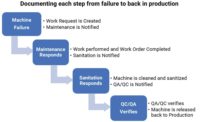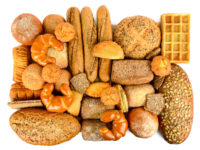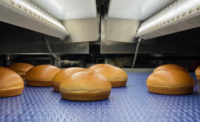The grain-based snack and bakery industry has a number of vital, perennially important food safety issues to consider as we move into a new year. Food safety has always been important in snack and bakery facilities, and it has ramped up this year due to COVID-19, as well.
Supply safety
“Today’s global snack foods industry is very complex. The diversity of ingredients, processing techniques, industry requirements, and supply chain models present many safety and quality challenges. Therefore, whether processors are utilizing wheat, rice, corn, soybeans, or other ingredients, rapid and accurate analytical results can help inspire smarter food safety decisions and ensure the integrity of product supply chains,” says Wes Shadow, market manager, grain, PerkinElmer, Inc., Waltham, MA.
“When dealing with grains, moisture is an especially important safety parameter as particularly damp or arid conditions can lead to the growth of carcinogenic mycotoxins. As such, regulatory thresholds for mycotoxins set by the global governing bodies, examples including the U.S. Food and Drug Administration, European Food Safety Authority, and the China Food and Drug Administration, are in place at various stages in the process and manufacturing pipeline to help minimize the risk of mycotoxin presence,” he says.
“To ensure supply chain safety, the industry is increasingly adopting sensitive, efficient detection methods that allow processors to monitor for the presence of mycotoxins at harvest, during storage, and before shipment or processing. PerkinElmer brings accuracy and ease of use to the forefront of mycotoxin testing with the AuroFlow AQ Mycotoxin Platform and new MaxSignals HTS Total Aflatoxins and DONA ELISA Kits,” Shadow notes.
The AuroFlow AQ Mycotoxin Alfa test strips allow farmers, grain silo workers and lab professionals to cover all six of the most commonly regulated mycotoxins in grains, he says.
“Through a single-step, water-based sample extraction, this quantitative solution is not only easy to use but is also more environmentally sustainable than traditional methods. When used in conjunction with PerkinElmer’s QuickSTAR Horizon portable strip reader, mycotoxins are detected in levels as low as 2 ppb in under 6 minutes making this analytical solution as rapid as it is robust. This USDA/FGIS approved solution also offers flexibility to be used on-site by farmers or by laboratory professionals due to its portability and user-friendly interface.”
Designed for complex matrices such as finished feed and grains, PerkinElmer’s MaxSignal HTS Total Aflatoxins and DON ELISA Kits provides an automated and easy-to-use mycotoxin testing workflow, Shadow adds.
“This solution allows lab teams to process up to 180 samples in 180 minutes. The new MaxSignal HTS offering has been developed to ‘set it and forget it,’ minimizing the need for manual intervention, reducing the risk of manual error and helping the customer meet their regulatory standards.”
Regulatory concerns
Earl Arnold, manager, food defense/FSMA, operations, quality assurance, Americas, AIB International, Manhattan, KS, says that the number one food safety priority should be allergens, as it is the number one reason for recalls in the U.S. “It is critical that manufacturers clearly define and follow label reviews, ensuring the right product goes into the right package and the label declares the correct allergens of the product. Additionally, if a facility has unique allergens, or those not common in all products and produced on shared equipment, then detailed change over cleaning is necessary to minimize allergen cross-contact,” he says.
“Additionally, the number one reason for FDA issuing 483s in 2019 and 2020 is not having a Foreign Supplier Verification Program, as required,” says Arnold. “Unfortunately, we are currently on track to repeat this in 2021. FDA sees education as the main gap for not understanding or capturing this requirement.”
Familiarity with FDA’s New Era of Smarter Food Safety will be beneficial, Arnold says. “This topic has been covered by FDA personnel at numerous speaking engagements and is what FDA is currently working on. It is important for manufacturers to stay current with topics like these, so they can be prepared if and when they become requirements. FDA has also proposed a new regulation for traceability requirements for high-risk foods. It is only in the beginning phase and has not formally approved this regulation. Some of these requirements may affect the snack and baking industry, as some of the ingredients listed like nut butters are commonly used in the industry.”
As for additional safety measures, Arnold says: “I see manufacturers maintaining several personnel safety measures after the pandemic. These include an increased focus on hand washing and hand sanitizing, increased cleaning frequency of high touch areas, and the continuation of visitor protocols.”
Kill steps
During the food manufacturing process, steps are often used to eradicate pathogens from products. These are called “kill steps.”
The American Bakers Association (ABA) collaborated with AIB International and researchers at Kansas State University and the University of Georgia to create Baking Process Kill Step Calculators. The calculators take recorded time and temperature parameters and automatically determines the total process lethality (e.g., 5 log) for Salmonella. They also give a standardized methodology to more than 2,000 bakery products on store shelves, and the calculators are approved by FDA; they also comply with the Food Safety Modernization Act (FSMA).
“The selection of product types for the kill step validation project was done to encompass a broad range of baked goods,” says Brian Strouts, technical advisor, ABA, Washington, D.C.
“The study was initiated with the hamburger bun as it was a fairly simple formulation and process. The testing methodology was also developed around this initial product as this type of testing was breaking new ground and was unpublished at the time. The most recent product, fruit-filled pastry, is a more complex multi component product but the testing principles still apply and the kill step calculation works the same way. In addition, the research team has now published several articles in peer reviewed journals that validate the models and the results,” he says.
Dave Bauman, food safety professional, operations, Americas, AIB International, Manhattan, KS, says that although most food products undergo a supposed kill step at the point of production, the process often lacks scientific documentary evidence or proof of effectiveness.
“Since 2011, FSMA has required all FDA-registered food manufacturing facility comply with the validation and verification of a kill step. Manufacturers must validate that the preventive controls that are identified and implemented are adequate to control the hazard as appropriate to the nature of the preventive control and its role in the facility’s food safety system,” says Bauman.
“Our Baking Process Kill Step Calculators help evaluate the lethality of your process in a variety of products. A report is then generated, which can be used as supporting documentation for FSMA’s validation and verification process. We currently offer 10 different Kill Step Calculators. This includes calculators for Cake Muffins, Crisp Cookies, Soft Cookies, Hamburger Buns, Whole Wheat Bread, Nut Muffins, Yeast Raised Donuts, Flour Tortillas, Cheesecake, and Fruit-filled Pastries,” Bauman adds.
“For each of the calculators, we collaborated with the American Bakers Association and its Food Technical and Regulatory Affairs Committee, along with researchers at Kansas State University and University of Georgia. Each of these calculators can help customers increase food safety assurance, while maintaining compliance with the Food Safety Modernization Act’s regulation for hazard analysis and preventive controls,” Bauman notes.
Pest control
Pest control continues to be an important issue in food facilities.
Glen Ramsey, technical services manager, Orkin, LLC, Atlanta, says that while we’re not quite in a post-pandemic phase yet, some pre-pandemic activities are resuming and that means pest activity will be as well. “We’ve continued to see an increase in rodent issues as their food sources are made available again and seasonal weather will begin to push pests inside to more temperate locations. Facility managers should work with their pest control provider to implement a strong exclusion program to keep pests out of their facilities. If staff are returning to work after the pandemic as well, it doesn’t hurt to get your pest control provider to do a refresher on staff training to help spot signs of pest activity,” he recommends.
Fly control remains a top concern for snack and bakery facilities, Ramsey notes. “Our new, state-of-the-art LED traps draw flies to an internal, non-toxic sticky board. This product provides better performance, less maintenance and increased energy efficiency. It’s also more sustainable than fluorescent insect light traps,” he says. “Prevention should still be the top priority and the best way to keep pests out is by implementing exclusion tactics such as installing door sweeps, sealing cracks and holes and performing regular inspections alongside your pest provider to see potential trouble spots in real time.”
In addition to exclusion tactics, areas that store food products are going to be a top concern for keeping pests out during the winter months. Keep all stored food products in airtight containers off the ground and away from exterior walls, Ramsey suggests.
“The garbage area is also a crucial hot spot for pests and should be part of routine inspection and maintenance. Place dumpsters as far away from your building as possible and make sure waste management comes to pick up and empty dumpsters at least twice a week to prevent food waste from sitting too long and attracting pests. Inside, make sure trash is emptied at least once a day and trash bins are hosed down and cleaned regularly to avoid any food build up,” says Ramsey.
Pat Hottel, technical manager, McCloud Services, a Terminix company, South Elgin, IL, says that in the Midwest, [the company has] seen unusually higher numbers of stored product pests like Psocids (booklice), cigarette beetles, and Indianmeal moths.
“This may be due to some of the unseasonably warmer temperatures that we saw later in the summer and into the fall. We also saw an increase in demand for both fumigation services and ULV space treatments in our control plans,” says Hottel.
“House mouse issues have also been on the rise. I would encourage facilities that do not already have a system in place for monitoring their shipping and receiving area center aisle to establish programs for these areas. Whether it be a visual inspection alone or supplemented with trap monitors, these programs are especially important if facilities have high external mouse activity. Additionally, thorough inspections of incoming shipments are a necessity,” Hottel recommends.
Hottel says that birds are often an issue around food manufacturing facilities due to the attractions of warmth, food, harborage, and water. “We have been using a relatively newer product on the market to keep these pests off of structures in the form of computer-generated laser devices. Hand-held lasers have been used for many years to harass birds inside structures to move them back outside. These units are installed outside to move them off buildings and structures. By reducing landing sites, we can reduce interior migrations and mitigate the food safety risks,” she explains.
“The Indianmeal moth pheromone has been available as both a lure for traps and as a dispenser for disrupting mating,” says Hottel. “It is now available as a sprayable formulation. While the dispensers remain our primary tool, there may be some areas where the sprayable is an option. We continue to look for sites where remote monitoring systems are good options and are currently using systems for rodents and stored product pests.”







